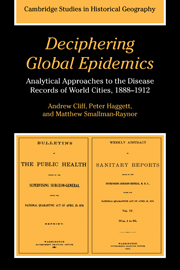 Deciphering Global Epidemics
Deciphering Global Epidemics Book contents
- Frontmatter
- Contents
- List of plates
- List of figures
- List of tables
- Foreword
- Preface
- 1 Prologue: epidemics past
- 2 The nature of the evidence
- 3 The global sample: an overall picture
- 4 Epidemic trends: a global synthesis
- 5 Comparing world regions
- 6 The individual city record
- 7 Epidemics: looking forwards
- Appendices
- Chapter notes
- References
- Index
- Cambridge Studies in Historical Geography
Preface
Published online by Cambridge University Press: 06 July 2010
- Frontmatter
- Contents
- List of plates
- List of figures
- List of tables
- Foreword
- Preface
- 1 Prologue: epidemics past
- 2 The nature of the evidence
- 3 The global sample: an overall picture
- 4 Epidemic trends: a global synthesis
- 5 Comparing world regions
- 6 The individual city record
- 7 Epidemics: looking forwards
- Appendices
- Chapter notes
- References
- Index
- Cambridge Studies in Historical Geography
Summary
One of the most familiar journals in the epidemiological world is the Morbidity and Mortality Weekly Report. Universally abbreviated as the MMWR, it lands on many thousands of desks early each week with clockwork regularity (or increasingly is drawn down through an electronic web). Published by the Epidemiology Program Office of the United States Centers for Disease Control and Prevention in Atlanta, it contains a mix of invaluable information on the distribution of epidemics and plagues around the world, advice about new vaccines or protective devices, the eruption of a new influenza strain here, an outbreak of Oropouche fever there.
At its heart lie a series of tables that record the data returned by the state epidemiologist for each of the states and territories of the United States on the numbers of reported cases of fifty-two notifiable diseases. To provide perspective, the data for the current week are compared with the cumulative totals for both the current and the preceding years. The morbidity tables are supplemented by a mortality table that gives, for 121 of its great cities, from Boston to Washington, DC, the pattern of pneumonia and influenza deaths reported for the current week.
The MMWR is valued for its timeliness and its immediacy. As with a weather bulletin, the main interest is in the most recent readings and what they presage for the weeks and months ahead. Will a new influenza strain be sweeping the world?
- Type
- Chapter
- Information
- Deciphering Global EpidemicsAnalytical Approaches to the Disease Records of World Cities, 1888–1912, pp. xxi - xxivPublisher: Cambridge University PressPrint publication year: 1998


